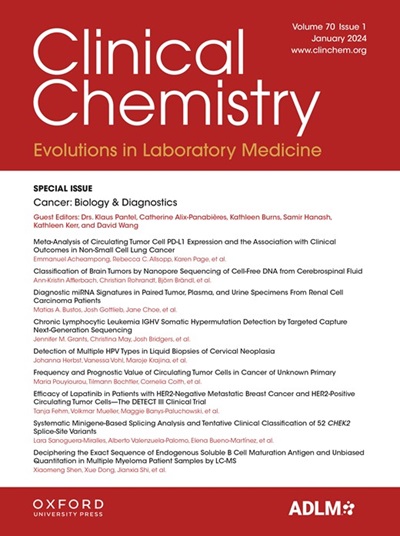A-088 Clinically Significant Errors Using the Diazyme Total Bile Acid Assay on the Roche c502 Analyzer: Investigating a Result Error Identifies a Novel Large-Scale Testing Error Caused by Reagent Carryover
IF 7.1
2区 医学
Q1 MEDICAL LABORATORY TECHNOLOGY
引用次数: 0
Abstract
Background Thoroughly investigating single patient result errors may identify systemic, large-scale testing errors. The laboratory observed an event where a revision to a Total Bile Acid (TBA, Diazyme Laboratories, Inc.) patient result following a 22S quality control (QC) failure displayed a larger than expected difference (52 to 5mcmol/L). TBA is primarily used for diagnosis and monitoring of intrahepatic cholestasis of pregnancy with results >10mcmol/L considered elevated. Retrospective review of result revisions following QC failures (3/15/2017-5/30/2023) revealed that 50%(20/40) yielded result differences of >10mcmol/L(>20SD based on assay imprecision). The aim of this study was to apply a systematic approach to i) estimate the rate of TBA errors, ii) ensure accurate result reporting during investigation period, iii) perform root cause analysis (RCA), and iv) determine corrective and preventative action(s). Methods Residual samples from TBA testing (6/24-7/5/2023) were retested(n=158), differences >+/-3.0mcmol/L or 15% were confirmed on an alternate analyzer, and reports were revised. Automated repeat testing of TBA samples >10mcmol/L was operationalized 7/6/2023. Initial and repeat TBA results were compared(n=448) and results differing by >+/-20% were remeasured on an alternate analyzer. RCA was conducted using a fishbone diagram. NaOH reagent probe washes were implemented for TBA and the error rate was re-assessed. Assays run prior to TBA samples with errors (n=15) were identified. To assess reagent carryover a residual serum pool (TBA ∼5mcmol/L) was aliquoted into 5 tubes in a sample rack. The first sample in the rack was programmed to run an assay suspected of causing carryover followed by 4 TBA measurements. Mean±standard deviation(SD) TBA concentrations were calculated. TBA was also measured in the liquid reagent for amylase, lipase, acetylcholinesterase (ACE) and fructosamine. Results Initial TBA retesting yielded no errors when initial TBA was ≤10mcmol/L(n=51). For samples with TBA >10mcmol/L(n=107), 9(8.4%) had differences exceeding criteria with 8/9 being revised to ≤10mcmol/L. Analysis of automated patient repeat data showed a 3.8%(17/448) error rate when initial TBA >10mcmol/L. After NaOH reagent probe washes were implemented, the error rate decreased to 0.7%(3/448). Assays run directly before an erroneously high TBA result included: lactate, fructosamine, soluble transferrin receptor(STFR), lipase, and ACE. A serum TBA pool(mean±SD=5.1±0.4 mcmol/L,n=15) measured 37.6±1.2mcmol/L(n=3) and 6.7±0.7mcmol/L(n=3) after lipase and fructosamine, respectively. No other assays demonstrated carryover. TBA in lipase reagent compartment B and C was 653 and 649mcmol/L, respectively, and 653mcmol/L in fructosamine reagent compartment B. Conclusions A single patient TBA result revision was investigated and led to identification of reagent carryover causing erroneously high TBA results on the Roche c502 analyzer. Automatic, real-time, repeat testing was implemented to prevent reporting incorrect patient results until RCA could identify the cause. Occurrence rate of erroneous high TBA results decreased from 3.8% to 0.7% after implementation of NaOH washes on the instruments. Carryover experiments confirmed that lipase and fructosamine assays cause carryover when run prior to a TBA sample due to measurable TBA in the reagent. The lab is pursuing moving the fructosamine and lipase reagent to the Roche Cobas c701 to prevent the issue.A-088 在罗氏c502分析仪上使用Diazyme总胆汁酸测定出现的临床重大错误:对结果错误的调查发现了由试剂携带引起的新型大规模检测错误
背景 对单个病人的结果错误进行彻底调查可能会发现系统性的、大规模的检测错误。实验室发现,在一次 22S 质量控制(QC)失败后,对患者总胆汁酸(TBA,Diazyme Laboratories, Inc.TBA主要用于诊断和监测妊娠肝内胆汁淤积症,其结果为10mcmol/L,即为升高。回顾性审查质量控制失败后的结果修订(3/15/2017-5/30/2023)发现,50%(20/40)的结果差异为>10mcmol/L(基于检测不精密度的>20SD)。本研究的目的是采用一种系统方法来 i) 估算 TBA 误差率;ii) 确保在调查期间准确报告结果;iii) 执行根本原因分析 (RCA);以及 iv) 确定纠正和预防措施。方法 对 TBA 测试(6/24-7/5/2023)的残留样品进行重新测试(n=158),在备用分析仪上确认差异>+/-3.0mcmol/L 或 15%,并修改报告。2023 年 6 月 7 日,TBA 样品>10mcmol/L 的自动重复检测开始运行。对初次和重复的 TBA 结果进行比较(n=448),如果结果相差 >+/-20%,则在备用分析仪上重新测量。采用鱼骨图进行 RCA。对 TBA 采用 NaOH 试剂探针清洗,并重新评估误差率。确定了在 TBA 样品之前运行的有误差的化验(n=15)。为评估试剂携带,将残留血清池(TBA ∼5mcmol/L)等分到样品架上的 5 个试管中。对样品架中的第一个样品进行编程,以运行被怀疑会导致携带的检测,然后进行 4 次 TBA 测量。计算 TBA 浓度的平均值± 标准偏差(SD)。在淀粉酶、脂肪酶、乙酰胆碱酯酶(ACE)和果糖胺的液体试剂中也测量了 TBA。结果 当初始 TBA ≤10mcmol/L(n=51)时,初始 TBA 复测无误。对于 TBA >10mcmol/L 的样本(n=107),9 个样本(8.4%)的差异超过了标准,其中 8/9 个样本被修订为≤10mcmol/L。对患者自动重复数据的分析表明,当初始 TBA >10mcmol/L 时,错误率为 3.8%(17/448)。使用 NaOH 试剂清洗探针后,错误率降至 0.7%(3/448)。在 TBA 结果过高之前直接进行的检测包括:乳酸、果糖胺、可溶性转铁蛋白受体(STFR)、脂肪酶和 ACE。在脂肪酶和果糖胺检测后,血清 TBA 池(平均值±SD=5.1±0.4 mcmol/L,n=15)分别测得 37.6±1.2mcmol/L (n=3)和 6.7±0.7mcmol/L (n=3)。其他检测均未显示出携带现象。脂肪酶试剂 B 区和 C 区的 TBA 分别为 653 和 649mcmol/L,果糖胺试剂 B 区的 TBA 为 653mcmol/L。在 RCA 找出原因之前,实施了自动、实时、重复测试,以防止报告错误的患者结果。在对仪器进行 NaOH 清洗后,TBA 偏高的错误结果发生率从 3.8% 降至 0.7%。迁移实验证实,由于试剂中含有可测量的 TBA,在 TBA 样品之前进行脂肪酶和果糖胺检测会导致迁移。实验室正在设法将果糖胺和脂肪酶试剂转移到罗氏 Cobas c701 上,以避免出现这一问题。
本文章由计算机程序翻译,如有差异,请以英文原文为准。
求助全文
约1分钟内获得全文
求助全文
来源期刊

Clinical chemistry
医学-医学实验技术
CiteScore
11.30
自引率
4.30%
发文量
212
审稿时长
1.7 months
期刊介绍:
Clinical Chemistry is a peer-reviewed scientific journal that is the premier publication for the science and practice of clinical laboratory medicine. It was established in 1955 and is associated with the Association for Diagnostics & Laboratory Medicine (ADLM).
The journal focuses on laboratory diagnosis and management of patients, and has expanded to include other clinical laboratory disciplines such as genomics, hematology, microbiology, and toxicology. It also publishes articles relevant to clinical specialties including cardiology, endocrinology, gastroenterology, genetics, immunology, infectious diseases, maternal-fetal medicine, neurology, nutrition, oncology, and pediatrics.
In addition to original research, editorials, and reviews, Clinical Chemistry features recurring sections such as clinical case studies, perspectives, podcasts, and Q&A articles. It has the highest impact factor among journals of clinical chemistry, laboratory medicine, pathology, analytical chemistry, transfusion medicine, and clinical microbiology.
The journal is indexed in databases such as MEDLINE and Web of Science.
 求助内容:
求助内容: 应助结果提醒方式:
应助结果提醒方式:


